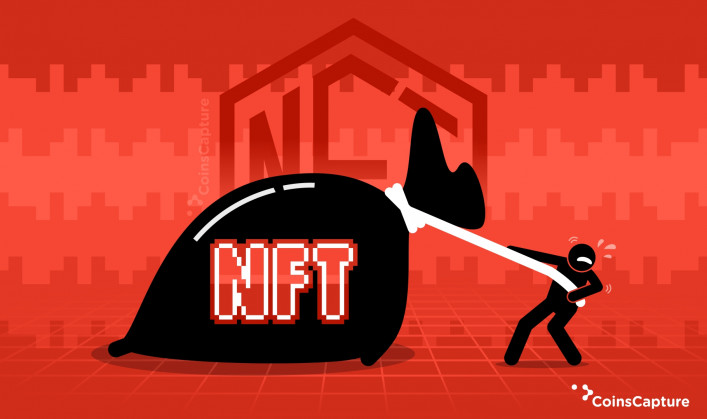7 November 2025
5 Largest Rug Pulls in NFT History
There is nothing admirable about a "rug puller." Things are certain to go wrong, whether it be a person tripping and falling or an item of furniture tipping over, or in the case of the NFT sector, many individuals losing a significant amount of income. Cryptocurrency creators that use bait and switch tactics to entice early investors before abruptly walking away from their projects are engaging in a rug pull strategy. Sometimes they disappear with the initiative money, or they sell off their pre-mined assets. This is done in either scenario to steal from the people who invested in the enterprise. Those planning a rug pull will wait until a project's NFT values have risen sufficiently high, at which point the developers will move the money out of the ecosystem and disappear, leaving investors with little redress. Okay, so here is the bad part about Web3.
Also Read: 10 Best NFT Marketplace Development Firms In USA
According to data compiled by The Block, the trading volume of NFTs throughout the globe increased dramatically in 2021, reaching over $13 billion. The previous year, Non-Fungible Token trading volume achieved just $33 million, thus this increase is dramatic. The mainstream press is saturated with stories of individuals who have made millions off of this trend, fueling the frenzy.
Also Read: 12 Best Football Club Enthusiast Token Of 2022
These are five of the largest rug pulls ever pulled by the NFT:
1. Frosties
For its release on January 7, 2022, the "cold, tasty, and unusual Frosties set of 8,888 NFTs went to considerable measures to sell itself as ice-cream. The creators, Ethan Nguyen ("Frostie") and Andre Llacuna ("heyandre"), had amassed a considerable following in their Discord and also had pledged collectors merchandise, lotteries, as well as a money to assure the project's sustainability. At a price of 0.04 ETH per mint, the Non-Fungible Tokens generated 335 ETH for the project's creators, or little more than $1 million, after just a few hours of sales. The sale proceeds were then sent to multiple wallets, as well as the project's website and Discord server were shortly taken down. Those who had invested in the group were unable to get in touch with its creators and were therefore left with nothing except their digital artwork and a plethora of negative emotions.
2. Blockverse
The recent swindle involving Blockverse, a Non-Fungible Token initiative, has cast doubt on the veracity of software created by unknown parties. As stated, the initiative raised 500 ETH after selling out in under eight minutes. Regrettably, after receiving the funding, the devs vanished, taking the initiative site as well as Discord server with them. It turns out that 4,200 people, as per OpenSea, are the proud owners of the NFTs in the archive. In addition, 793 ETH which is about $1.9 million that has been traded on the marketplace as a result. Regrettably, Blockverse NFT was a complete farce.
3. Big Daddy Ape Club
There were going to be 2,222 ape-themed Non-Fungible Tokens comprising Big Daddy Ape Club (BDAC), which would have been issued on the Solana blockchain as well as made available for purchase on the Solanart platform. BDAC stands out as the most excruciating rug pull in the whole history of the Solana blockchain. Project designers often put up certain non-fungible token art and afterwards disappear with the funds in a rug pull. But BDAC was able to mint its NFTs by collecting 9,136 SOL (equivalent to about $1.3 million at the time). Only, there were never such NFTs to begin with. Unfortunately, BDAC removed the project's Twitter and website, as well as closed down the Discord server, in the hours leading up to the mint. Despite everyone's best efforts, nobody has seen their NFTs materialize.
4. Mercenary
The mercenary fraudsters boosted their Twitter following by paying for ads on Cryptocurrency news sites such as BSC News. This one was, meanwhile, an elaborate fraud. To the tune of $760,000, the fraudsters behind Mercenary Gold, who run a company that keeps track of rug pulls and other forms of fraud in the Cryptocurrency market, were successful. There seems to be nothing left on Mercenary's social media profiles even in the cached versions available by Google Cache as well as the Internet Archive. But the game has to have a longstanding experience of sponsored tweets. In addition to being a pleasant feature, the latter's 8-bit design seemed fairly genuine. Unfortunately, it was all an elaborate hoax.
5. Baller Ape Club
The group responsible for yet another ape-based Non-Fungible Token project is struggling. The Department of Justice (DOJ) has just filed charges against Le Anh Tuan, the creator of Baller Ape Club (BAC), for conspiracy to conduct wire fraud as well as conspiracy to attempt global money smuggling. Allegedly, Tuan took $2.6 million from participants in BAC, launched the collections, took down the project's website, as well as laundered the cash. The DOJ claims that Tuan "chain-hopped" the money, or changed them to other Cryptocurrencies before sending them to several blockchains. The Department of Justice calls this "the biggest known NFT scam to date."
Disclaimer: The author’s thoughts and comments are solely for educational reasons and informative purposes only. They do not represent financial, investment, or other advice.






